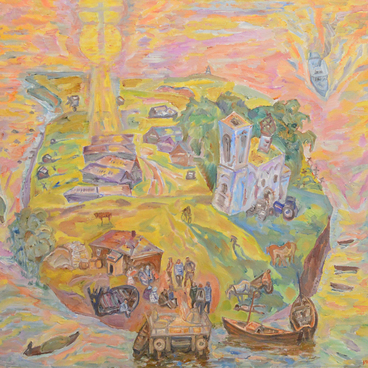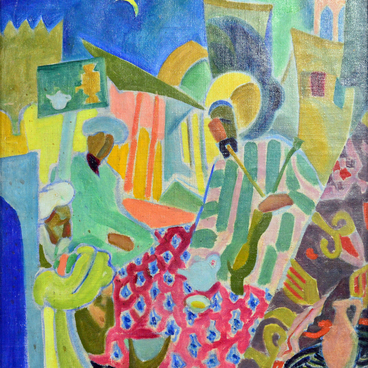In the Orthodox iconography it’s common to distinguish no more than 10 general types of a canonic image of the Mother of God. However, the number of images of the Mother of God is more than 250 icons. This can be explained with the fact that canonic images were distributed via the copied images, and later on they were influenced by characteristic features of local icon painting. But the basis was always Byzantine and Western European originals and church texts.
The Mother of God’s images were often created after its miraculous appearances in different places, and in such cases the image combined features of the regional school layered on one of the typological originals. The copy of a wonderworking icon of Akhtyrskaya Mother of God is one of them.
According to the legend, in 1739 a priest Vasily Danilov saw an image of Mother of God in Akhtyrka in Kharkov Governorate. During the haymaking in the field he saw an icon with the Virgin Mary’s face, which was emitting light. The image told him to wash the icon and cover it with a piece of cloth. The priest did it. In the morning he was going to pour out the water he used to wash the icon with, but he was told by a vision to leave it and give it to his daughter to drink. The girl had a fever, but after drinking the water she got well. Thanks to the icon, more than 300 miraculous recoveries took place. Empress Elizaveta Petrovna heard the rumours about the wonderworking icon, and she allocated means for the church construction. A lot of copies of the image were made and it got widespread in the nearby areas, in the Southern Russia.
The icon from the museum collection is a copy of a wonderworking icon dated mid-to-late 18th century and painted in the southern tradition. The image belongs to the type Lament of the Blessed Virgin Mary, where she is depicted with hands on her chest in front of the cross. It’s interesting that many variants of this icon were made in technique of parallel perspective, when objects on the foreground are bigger than the ones on the background. In icons it was common to depict objects in reversible perspective, unfolding and bringing them closer to the viewer. In this case Mother of God slightly goes to the background but, in general, parallel perspective remains in force.
The Virgin Mary is shown with her hair down, her head is uncovered, which is also rare in iconography. Around the perimeter there’s an ornamented gilded frame. In Ukraine such frames were usually decorated with flowers and gilded.
History of the Akhtyrskaya Mother of God is complicated. According to one of the versions, it was stolen in 1903, when it was taken to Saint Petersburg for restoration. The other version says it disappeared after 1917 from Akhtyr church. For a long time there was no information on its location. It only appeared in 1975 in San Francisco. The copy was returned to the country 20 years later. In June 2010 the image was given to Voskresensky Novodevichy Convent, where it is kept now.
The Mother of God’s images were often created after its miraculous appearances in different places, and in such cases the image combined features of the regional school layered on one of the typological originals. The copy of a wonderworking icon of Akhtyrskaya Mother of God is one of them.
According to the legend, in 1739 a priest Vasily Danilov saw an image of Mother of God in Akhtyrka in Kharkov Governorate. During the haymaking in the field he saw an icon with the Virgin Mary’s face, which was emitting light. The image told him to wash the icon and cover it with a piece of cloth. The priest did it. In the morning he was going to pour out the water he used to wash the icon with, but he was told by a vision to leave it and give it to his daughter to drink. The girl had a fever, but after drinking the water she got well. Thanks to the icon, more than 300 miraculous recoveries took place. Empress Elizaveta Petrovna heard the rumours about the wonderworking icon, and she allocated means for the church construction. A lot of copies of the image were made and it got widespread in the nearby areas, in the Southern Russia.
The icon from the museum collection is a copy of a wonderworking icon dated mid-to-late 18th century and painted in the southern tradition. The image belongs to the type Lament of the Blessed Virgin Mary, where she is depicted with hands on her chest in front of the cross. It’s interesting that many variants of this icon were made in technique of parallel perspective, when objects on the foreground are bigger than the ones on the background. In icons it was common to depict objects in reversible perspective, unfolding and bringing them closer to the viewer. In this case Mother of God slightly goes to the background but, in general, parallel perspective remains in force.
The Virgin Mary is shown with her hair down, her head is uncovered, which is also rare in iconography. Around the perimeter there’s an ornamented gilded frame. In Ukraine such frames were usually decorated with flowers and gilded.
History of the Akhtyrskaya Mother of God is complicated. According to one of the versions, it was stolen in 1903, when it was taken to Saint Petersburg for restoration. The other version says it disappeared after 1917 from Akhtyr church. For a long time there was no information on its location. It only appeared in 1975 in San Francisco. The copy was returned to the country 20 years later. In June 2010 the image was given to Voskresensky Novodevichy Convent, where it is kept now.

